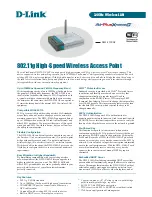
Single Point Setup
Single Point Setup Overview
Cisco Small Business WAP371 Wireless Access Point Administration Guide
144
10
all members of the cluster, and the configured WAP device assumes control of the
cluster.
•
When two separate Single Point Setup clusters join into a single cluster, then the latest
modified cluster wins arbitration of the configuration and overwrites and updates the
configuration of all clustered WAP devices.
•
If a WAP device in a cluster does not receive advertisements from a WAP device for
more than 60 seconds (for example, if the device loses connectivity to other devices in
the cluster), the device is removed from the cluster.
•
If a WAP device in Single Point Setup mode loses connectivity, it is not immediately
dropped from the cluster. If it regains connectivity and rejoins the cluster without
having been dropped, and configuration changes were made to that device during the
lost connectivity period, the changes are propagated to the other cluster members when
connectivity resumes.
•
If a WAP device in a cluster loses connectivity, is dropped, later rejoins the cluster, and
configuration changes were made in the during the lost connectivity period, the
changes are propagated to the device when it rejoins. If there are configuration changes
in both the disconnected device and the cluster, then the device with the greatest
number of changes and, secondarily, the most recent change, will be selected to
propagate its configuration to the cluster. (That is, if WAP1 has more changes, but
WAP2 has the most recent change, WAP1 is selected. If they have an equal number of
changes, but WAP2 has the most recent change, then WAP2 is selected.)
Operation of a Device Dropped From a Single Point Setup
When a WAP device that was previously a member of a cluster becomes disconnected from
the cluster, the following guidelines apply:
•
Loss of contact with the cluster prevents the WAP device from receiving the latest
operational configuration settings. The disconnection results in a halt to proper
seamless wireless service across the production network.
•
The WAP device continues to function with the wireless parameters that it last received
from the cluster.
•
Wireless clients associated with the non-clustered WAP device continue to associate
with the device with no interruption of the wireless connection. In other words, loss of
contact with the cluster does not necessarily prevent wireless clients associated with
that WAP device from continued access to network resources.
•
If the loss of contact with the cluster is due to a physical or logical disconnect with the
LAN infrastructure, network services out to the wireless clients may be impacted
depending on the nature of the failure.
















































